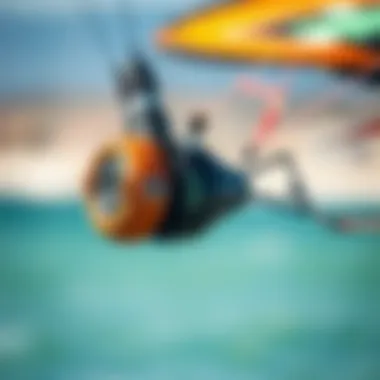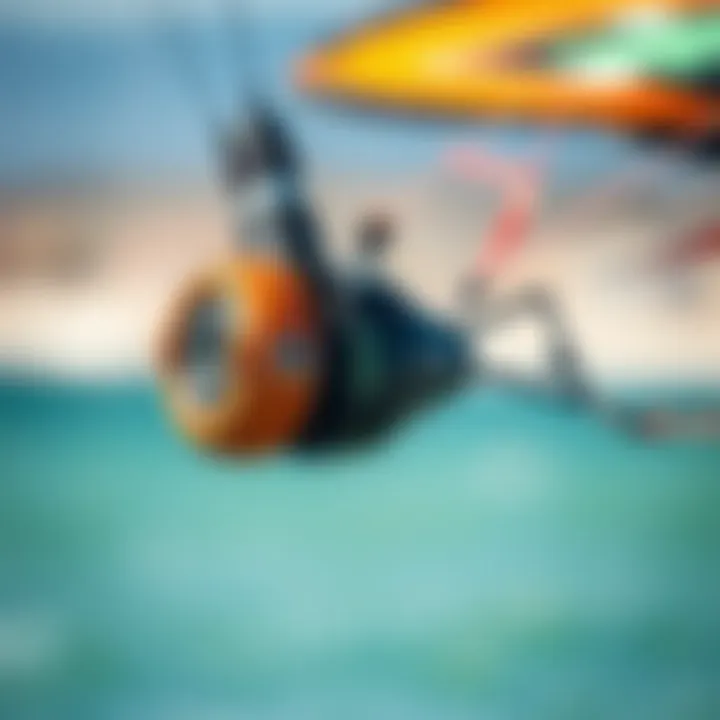Discovering the Best Sport Kites for Sale Today


Intro
When we talk about sport kites, it’s not just about flying a colorful piece of fabric in the sky. There’s a world teeming with options, technologies, and techniques waiting to be explored. For both newcomers and seasoned kiteboarders, understanding the nuances of the sport kites available for sale can make all the difference in crafting enjoyable experiences. A sport kite can elevate your sessions, providing both a thrilling challenge and the satisfaction of mastering the wind.
This guide dives deep into the essentials: from types of kites to tech advancements. In the coming sections, we’ll discuss equipment insights, including the latest gear reviews and vital maintenance tips. The goal is to arm you with the knowledge needed to make informed choices, regardless of your experience level. So buckle up as we embark on this journey through the intricate universe of sport kites.
Equipment Insights
Selecting the right sport kite is crucial for enjoying the experience, and this section aims to break down key aspects that will assist you in this decision.
Latest Gear Reviews
With manufacturers consistently pushing the envelope, new models roll out regularly. Differentiating between durable, high-performance kites and those best suited for beginners is essential.
- Paradigm 2-String Kite: This beginner-friendly option combines ease of use with robust durability. Its lightweight design enables smooth handling even in mild winds.
- Kitech Pro Series 3D: Aimed at enthusiasts pushing to advance their skills, this kite offers precision control and incredible speed. The attention to detail and quality materials used in its construction make it suitable for professional use.
- SkyMaster Eco-Venture: For the environmentally-conscious, this option is crafted from sustainable materials and still provides impressive performance. Its innovative design not only reduces environmental impact but offers a responsive flying experience.
These kites represent just the tip of the iceberg. Each comes equipped with features tailored to specific goals in mind, from maneuverability to speed and handling. Visiting online platforms like Reddit can yield firsthand user experiences that further inform your choices.
Essential Gear Maintenance
Once you invest in a kite, understanding how to maintain it is paramount for durability. Here are some practical tips:
- Clean Regularly: Dirt and sand can wear down fabric and the internal mechanisms. After each session, gently clean your kite with fresh water.
- Inspect Thoroughly: Before storing your kite, check for any signs of damage. Look for frayed lines or tears in the fabric – these can compromise performance.
- Proper Storage: Store your kite in a cool, dry place, ideally in a protective bag. Sunlight and moisture can gradually degrade materials.
Taking care of your equipment not only extends its life but also ensures peak performance when you need it most. Various forums and resources can provide additional insights—don’t hesitate to reach out to fellow enthusiasts!
Remember: An ounce of prevention is worth a pound of cure.
In the upcoming sections, we will explore techniques that cater to both beginners and advanced kiteboarders. From the foundations of flying to intricate maneuvers, there’s always room to grow and enjoy the sport further. Stay tuned!
Intro to Sport Kites
Sport kites represent a fascinating intersection between art, technology, and recreation. Understanding them is critical not only for enthusiasts but also for newcomers who might be looking to dive into the vibrant world of kite flying. This section aims to lay the groundwork for appreciating sport kites by examining their definition, historical context, and significance in today’s recreational landscape. The goal is to paint a picture that showcases the complexity and delight these crafts bring to participants and spectators alike.
Definition and Overview
At its core, a sport kite is more than just a piece of fabric tethered to some string. These kites are engineered for performance and handling, often featuring intricate designs that allow them to execute aerial maneuvers that can dazzle onlookers. Unlike traditional kites, sport kites are designed to be flown in various wind conditions and can incorporate multiple strings for added control.
To break it down further, here’s a basic overview of different characteristics of sport kites:
- Aerodynamics: Sport kites are crafted to maximize lift and maneuverability. Their unique shapes contribute significantly to their performance in the air.
- Lines and Control: Most sport kites come with dual, or quad-line control systems, enabling the flyer to steer and perform tricks.
- Materials: High-quality materials such as ripstop nylon and reinforced fibreglass or carbon fiber frames are commonly used to ensure durability while reducing weight.
These kites are not merely tools for aerial art; they encapsulate a cultural and technological evolution in the world of outdoor sports.
Historical Development
The history of sport kites is as colorful as the kites themselves. Traditional kites have been around for centuries, with roots tracing back to ancient China, where they served various purposes from sending messages to being used in military applications. However, sport kiting as a distinct activity really took off in the late 20th century.
In the early 1970s, American kite enthusiasts began experimenting with designs that prioritized ease of handling and performance. The introduction of modern materials and innovative designs transformed what was primarily a leisurely craft into a competitive sport. Events like kite festivals emerged, showcasing not just the flying associations, but also the artistry and creativity of builders around the world.
By the 1980s and 1990s, organizations began solidifying rules for competitions and performances. It was during this period that kites such as the Revolution kite gained immense popularity, known for their ability to perform tricks like flips and spins, captivating a wide audience.
Today, the community around sport kiting is expansive, with enthusiasts forming clubs and networks across the globe. Online platforms allow for greater collaboration, sharing techniques, and innovations in design helped propel the sport to new heights. It is a blend of culture, community, innovation, and a touch of whimsy that keeps the spirit of sport kiting alive and well.
In summary, grasping the definition and historical development of sport kites lays a strong foundation for anyone looking to explore this exhilarating pastime. As we delve deeper into the varieties and essential elements to consider when purchasing, understanding these foundational aspects will help enhance the overall appreciation and enjoyment of this captivating sport.
Types of Sport Kites
Understanding the different types of sport kites is crucial for anyone exploring this exhilarating hobby. Each type offers unique features and flight experiences, making it essential for enthusiasts to know what suits their needs and preferences.
Single Line Kites
Single line kites are the simplest form of kites and appeal to newcomers. These kites are often easy to fly and are great for anyone starting out.
- Usage: Beginner-friendly, perfect for family fun.
- Flight Characteristics: They tend to remain stable in winds and require minimal control.
Often, these kites come in bright colors and whimsical designs, adding to their appeal. Single line kites are often the first choice for casual flyers, who enjoy relaxing afternoons watching their kite soar. Their straightforward nature makes them a popular choice for kids and families. Furthermore, they are light on the pocket book and require less maintenance compared to their dual or quad line counterparts.
Dual Line Kites
Dual line kites are a significant step up in terms of maneuverability and control. With two lines instead of one, these kites offer enthusiasts the chance to perform tricks and acrobatics in the sky.
- Precision Control: They respond acutely to the pilot's movements.
- Trick Potential: Capable of performing incredible stunts, enhancing the thrill factor.
A note on benefits: These kites not only provide a more engaging flying experience but also allow users to connect deeper with the sport. Flying a dual line kite can feel like an art form, where the flier learns to read the wind and interact with the kite, almost like an extension of themselves. This level of engagement makes it perfect for hobbyists looking to deepen their passion.
Quad Line Kites
Quad line kites are the most complex among the types discussed. They provide a very advanced flying experience, granting the pilot even greater control.
- Control Specifications: Four lines allow for various movements, including backward flying and hovering.
- Performance: These kites can perform complex tricks and stunts, appealing to seasoned enthusiasts.
Flying a quad line kite isn't just about the wind; it's about the finesse of control. This type greatly enhances the experience for those who have a strong desire to push their limits. The challenge and satisfaction of mastering a quad line kite can be immensely rewarding. It's not unusual for community events to include impressive displays from those skilled at flying these kites, showcasing their intricacies and capabilities.


"In the world of kite flying, the type of kite one chooses not only reflects personal taste but also introduces unique experiences and challenges that shape one's journey as an enthusiast."
Now, understanding these types allows potential buyers to make informed decisions, ensuring they select the possibly suited to their skill level and flying ambitions.
Features to Consider When Purchasing Sport Kites
When diving into the vibrant world of sport kites, it’s imperative to understand what sets one kite apart from another. The right choices can significantly enhance your experience, performance, and satisfaction. While some elements may seem trivial, they play a vital role in ensuring you get the best out of your time spent flying. In this section, we shall explore crucial features that buyers should carefully evaluate, guiding you toward informed purchases.
Material Quality
First and foremost, the material used in constructing a sport kite impacts its performance, durability, and overall handling. Kites often feature ripstop nylon or polyester that lends both strength and lightness. If you opt for something heavy, like certain canvas styles, it might perform wonderfully in calm conditions but struggle during gusty winds.
- Gosharp kites utilize special materials that resist tearing, making them suitable for long-term use.
- Kites made with lower quality fabrics may save you a few bucks initially but will likely demand replacement sooner than you'd hope.
So, pay attention to the fabric and its weaving; opting for quality will often mean fewer headaches down the road.
Design and Aerodynamics
The design of a kite is the difference between a spectacular aerial dance and a tangled mess on the ground. Aerodynamics focuses on how the kite interacts with the wind. Factors such as shape, wing span, and profile all serve to dictate how well a kite will perform in various conditions.
- A delta-shaped kite can maneuver smoothly in light winds, while a box frame might excel at higher velocities.
- Furthermore, considering color patterns isn’t just for aesthetics. Bright colors often offer better visibility, ensuring you can track your kite during flight.
When selecting, keep in mind the specific conditions you plan to fly in: certain designs will make all the difference.
Control Mechanisms
Navigating the skies requires more than just wishful thinking; it demands precise control. The way a kite is managed—the control line setup—is paramount. Single-line kites are simpler and often recommended for beginners. Dual-line and quad-line kites provide more control over flight but require practice to master.
- Dual-line setups give pilots the ability to turn more sharply with the pull of the right or left line. This option increases the potential for acrobatic maneuvers.
- Quad-line configurations add another layer, allowing for advanced handling and tricks, making them popular among seasoned flyers.
If you’re new to the sport, understanding these control mechanisms will make your learning curve much less steep.
Wind Range Suitability
No two days are the same when it comes to weather, and thus, knowing your kite's wind range is crucial. Every kite has an optimal wind range, and flying outside that parameter can lead to disappointment or worse—damage.
- Check manufacturer specifications: Many kites will indicate their minimum and maximum wind speeds.
- Beginners might want to start with kites ideal for a broader range to accommodate varying conditions.
Choosing the right kite for expected wind conditions will save you from chasing after your sport kite or wrestling with it on the ground.
"Understanding features like material quality, aerodynamics, control mechanisms, and wind suitability can make the difference between an enjoyable flight and a frustrating experience."
Top Brands for Sport Kites
When it comes to choosing a sport kite, the brands behind these flying marvels play a significant role in determining the quality, performance, and durability of the equipment. Top brands have built their reputation through consistent innovation, customer satisfaction, and attention to detail. They cater to both novices and experienced enthusiasts, offering a variety of options suited to different skill levels and preferences. A solid understanding of these brands not only guides your purchasing decisions but also enhances your overall experience in the sport. Some of the elements to consider when evaluating the top brands include:
- Quality Materials: A reputable brand ensures that their kites are made from durable, lightweight materials that can withstand the rigors of sport kiting.
- Performance Level: Different brands specialize in various types of kites, so knowing which brands excel in dual-line or quad-line designs can steer you toward the right fit.
- Customer Support: Established companies usually have reliable customer service, which can be a lifesaver if you encounter issues or need repairs.
Let's explore a few of the leading brands in the sport kite market.
Brand A
Brand A stands at the forefront when it comes to dual-line kites, known for their excellent stability and responsiveness. This brand prioritizes user-friendly designs, making it particularly appealing for those just starting out. The beauty of Brand A lies in its commitment to innovation; their kites often include advanced features like adjustable wings and easy-assembly structures, catering to newbies and seasoned pilots alike.
Moreover, they make a variety of models that cater to different preferences, ensuring there's something for everyone. If you're considering a kite from Brand A, expect to experience smooth flights that help you learn control and maneuverability quickly.
Brand B
Brand B has become synonymous with quality and precision. Their quad-line kites are especially popular with those who wish to dive into acrobatic maneuvers. What sets Brand B apart is its attention to detail, both in design and crafting. Each kite is built to maximize performance and withstand challenging conditions.
Many enthusiasts appreciate the aesthetic designs and vibrant colors of Brand B kites, which add flair to any kiteboarding session. When you purchase a kite from this brand, you can confidently expect a solid performance, especially on windy days.
Brand
Brand C embodies a more budget-friendly approach without sacrificing quality. This brand strives to provide entry-level options, perfect for beginners seeking to enter the world of sport kiting. Their kites are made from solid materials that offer durability while being easy to handle. What really shines with Brand C is their commitment to education; they often provide resources and guides to help newcomers get started.
Ultimately, if you’re unsure where to start and want an affordable, reliable kite, Brand C has a lot to offer. Their kites come highly recommended by instructors and local enthusiasts trying to kick off their experience in kiting.
"Choosing the right brand can make a world of difference in your sport kiting journey, impacting your learning curve and overall enjoyment."
By considering these top brands, you can take a significant step towards finding the right sport kite that meets your needs, skill level, and budget.
Where to Buy Sport Kites
Finding the right place to purchase sport kites can greatly influence your experience, whether it’s your first kite or an upgrade to your existing collection. When selecting a source for your kite, it’s not just about price but also about trustworthiness, quality, and customer service. Each option offers advantages, and understanding these can guide both newbies and seasoned enthusiasts toward smart buying decisions.
Online Retailers
Shopping online has grown immensely popular, especially in the realm of sport kites. Advantages include the convenience of browsing from home, competitive pricing, and often, a wider selection. Websites that specialize in outdoor gear or dedicated kite shops typically carry the latest models, making it easier to compare specs and prices.
However, while online platforms can offer enticing deals, it’s crucial to ensure that the retailer is reputable. Customer reviews and ratings can provide insight into the quality of both the kites and the service. Moreover, many online stores offer detailed descriptions and photos, aiding in the decision-making process. Keep an eye out for websites such as:


While scores of options are out there, diligent research is key. Check return policies and read the fine print.
Local Shops and Specialty Stores
Walking into a brick-and-mortar store provides a tactile experience that online shopping lacks. Local shops or specialty stores often allow you to handle the kites first-hand. This can be especially helpful in assessing the material quality and design that suits your aerodynamics needs. Plus, local retailers might offer kite-flying lessons or community events, enriching your connection to the sport.
Be sure to engage with the staff; they usually have good knowledge about the products and can offer advice tailored to your skill level and interests. Beyond just making a sale, their goal is to foster a love for kiting. Popular local spots may include:
- Specialty outdoor retailers
- Local kite clubs' shops
Used Equipment Marketplaces
For budget-conscious buyers, considering used equipment can yield great finds. Platforms such as Facebook Marketplace, Craigslist, or dedicated forums allow enthusiasts to buy and sell pre-owned kites at reduced prices. Purchasing second-hand can not only save dollars but might lead you to vintage kites, which can carry a charm of their own.
When buying used, caution is of utmost importance. Thoroughly assess the kite's condition, looking for signs of wear or damage. Engaging with sellers in text or face-to-face can help gauge trustworthiness. Remember, it’s not just about finding a good price; it’s also about acquiring a reliable piece of equipment.
"Finding the right kite is like finding the right dance partner; the more you know about each other, the better the performance."
Navigating various purchasing avenues empowers you to make informed decisions, whether it's finding a high-flying challenger or a simple beginner's kite. Thus, arming yourself with all these insights can lead to not just an enjoyable purchase experience but also a rewarding kiting journey.
Understanding Costs of Sport Kites
Understanding the costs associated with sport kites is a vital part of making informed decisions for both newbie and seasoned kiteboarders. The price range for sport kites can vary significantly, and recognizing the distinctions between entry-level, mid-range, and high-end models can determine your overall kiting experience.
Whether you're just dipping your toes in the world of sport kites or you’re ready to take flight with premium gear, knowing what you are spending on and what you’re getting for your investment can save you both time and money. The clear understanding of costs aids in setting realistic expectations. With this perspective, let's break down the different price categories for sport kites, looking at key aspects to consider for each.
Entry-Level Kites
Entry-level kites typically cater to beginners who are looking to explore the sport without breaking the bank. These kites are often priced between $50 and $150, and they offer a decent quality that allows users to grasp the basics of flying. One can find various models available from popular brands such as Prism and HQ Kites.
When choosing an entry-level kite, one should keep the following in mind:
- Build Quality: While not as robust as higher-end models, look for kites that are made with decent materials, allowing for some degree of durability.
- Ease of Use: Look for kites that are easy to launch and land. When starting, minimizing complications is key to enjoying your flying experience.
Though they are budget-friendly, it's worth noting that these kites might not perform well in high winds or complex aerial tricks. Yet for those who aren't looking to compete and just want to enjoy a breezy day, entry-level kites are a solid choice.
Mid-Range Options
Mid-range kites range between $150 and $400, hitting that sweet spot for those who have gained some experience and want to step it up a notch. These kites tend to offer improved performance, better materials, and often come with enhanced features. Brands like Gokite and Flexifoil are well-regarded in this category.
When considering a mid-range kite, here’s what to look out for:
- Performance Enhancements: These kites generally handle better and provide more responsive control, allowing for smooth maneuvers and stability in tricky wind conditions.
- Customization Options: Many mid-range models come with a range of accessories and add-ons, such as attachable tails and specialized line sets, giving the pilot more ability to tailor the kite to their preferences.
These kites make for a perfect choice for those wishing to refine their skills while still keeping within a reasonable budget. They strike a balance between cost and quality, which can result in a more fulfilling kiting experience.
High-End Kites
High-end kites are for the committed kite enthusiast, ranging from $400 to well over $1,000. They showcase advanced materials, cutting-edge technology, and meticulous craftsmanship. Brands such as Ozone and Naish dominate this space.
Key considerations for high-end kites include:
- Material and Construction: Expect lightweight yet super strong materials designed to withstand tough conditions. The attention to detail in construction greatly enhances performance.
- Advanced Features: High-end kites often integrate sophisticated designs that improve aerodynamics, offering excellent control even during challenging weather.
- Warranty and Support: These products usually come with extended warranties, which signifies the manufacturer's confidence in the durability and longevity of their models.
Such kites are primarily suited for serious kiteboarders focused on high performance, whether for competitive purposes or advanced recreational flying.
In essence, understanding the costs associated with sport kites, from entry-level to high-end options, not only lays a foundation for making wise investments but also shapes the overall enjoyment of this thrilling sport. Engaging with the community can also bring insights into your possible purchases.
Maintenance and Care for Sport Kites
Caring for your sport kite is akin to maintaining a fine instrument. Regular maintenance ensures longevity and enhances performance, which is vital whether you're flying for recreation or competition. Neglecting care can lead to costly repairs or poor flight experiences. By understanding the fundamentals of maintenance, you can enjoy your sport kite for years and enhance your overall kiting experience.
Cleaning and Storage
To begin with, cleaning your sport kite is essential. Just as you wouldn’t let dirt pile up on a beloved guitar, dirt and debris can adversely affect your kite's performance. After each outing, take a few moments to check for any sand, mud, or other remnants stuck to the fabric. For cloth kites, a soft brush can do wonders to sweep away light dirt. If the fabric is particularly dirty, a gentle wash with mild soap and water works well. Remember, abrasive cleaners can damage the material, so stick to the gentle stuff.
When it comes to storage, not all kites are created equal. Ensure your kite is dry before putting it away; moisture can lead to mold, which can ruin the fabric. Use a protective bag if you have one, and keep it out of direct sunlight when not in use, as UV rays can degrade the material over time. An excellent tip is to store your kite flat, not rolled, if you can—this helps maintain its shape and prevents creasing or bending.
Repairing Minor Damages
Even the best-laid plans can lead to a snag here and there. If you find minor damage to your kite, such as small tears or misaligned bridle lines, don’t panic. Repairing these issues can be straightforward. For light tears, a specialized kite tape can work like magic. This tape is designed to bond with the fabric and create a waterproof seal, ensuring that your kite is ready for the next kite-flying adventure. Be sure to clean the area around the tear before applying the tape; a clean surface promotes better adhesion.
If a bridle line is fraying or knotting, replace it as soon as possible. A faulty bridle can impact control and lead to a less enjoyable flying experience. Find the manufacturer's recommendations for proper replacement parts to ensure consistency and performance with your kite. If you encounter a problem that seems beyond your comfort level, don’t hesitate to reach out to a professional for help.
"An ounce of prevention is worth a pound of cure." This age-old saying rings particularly true in the world of kiteboarding. Regular maintenance and timely repairs can save you a lot of heartache, not to mention cash.
Overall, being diligent with maintenance and care will help you maximize the fun and thrill that comes with the sport kite experience. Make it a habit to inspect your gear regularly, clean it after flights, and tackle any repairs swiftly. By doing this, you’re setting yourself up for endless skies filled with joy.
Safety Considerations in Kiteboarding
When it comes to kiteboarding, safety can't be an afterthought. The exhilaration of flying a sport kite can be overshadowed by the potential risks involved. Understanding the importance of safety not only ensures a more enjoyable experience, but also cultivates a culture of responsibility and awareness within the kiteboarding community. Whether you're just starting or you're a seasoned pro, recognizing the safety concerns associated with kiteboarding is paramount.
Equipment Safety Tips


Having the right equipment is foundational to a safe kiteboarding experience. Here are a few safety tips regarding your gear:
- Regular Inspections: Before you hit the water, thoroughly check your equipment. Look for wear and tear on lines, the kite fabric, and connectors. Even small issues can lead to bigger problems.
- Proper Justification of Gear: Ensure that your kite matches your skill level. An advanced kite can be difficult to control for a beginner. It's better to start with something more forgiving.
- Personal Protective Equipment: Wearing a helmet and impact vest could save your skin from nasty falls or even collisions. Don’t skimp on safety gear—you'll thank yourself later.
- Releasing Gear: Familiarize yourself with your safety release mechanism. It’s crucial that you know how to operate it quickly in case of an emergency.
Tips for Beginners in Sport Kiting
Sport kiting is not just a pastime; it’s an exhilarating blend of skill, technique, and passion. For newcomers to this activity, understanding the fundamentals can make all the difference between an enjoyable experience and one that leaves them frustrated. This segment aims to ease beginners into the world of sport kites, ensuring they have a solid foundation to build upon.
Choosing Your First Kite
The journey begins with selecting the right kite. It might seem like a straightforward task, but there are key factors to consider. Beginners often find themselves faced with many options, and it can be overwhelming. Here’s what to keep in mind when choosing your first kite:
- Type of Kite: Single line kites are often recommended for novices due to their simplicity and ease of use. They’re straightforward to launch and control, which is ideal when one is still learning the ropes. In contrast, dual or quad line kites, while offering advanced control and maneuvers, may require a steeper learning curve.
- Size Matters: The size of the kite should also match the wind conditions in your area. A larger kite catches more wind and can be exhilarating, but too much wind can lead to struggles in control. Beginners might favor kites in the 3 to 5-foot range when conditions are moderate, ensuring they don’t feel overwhelmed.
- Build Quality: It's beneficial to pick a durable kite that can withstand the occasional crash. Look for kites made from sturdy materials such as ripstop nylon for longevity, as these can endure the rough tumbles that often occur while one is still mastering their technique.
In fairness, choosing your first kite should feel like stepping into a new adventure rather than a chore. Aim for something that feels good in your hands, and don’t hesitate to seek advice from local shops or kite enthusiasts who can provide insights based on firsthand experience.
Learning the Basics of Control
Once you've got your kite, the next hurdle is learning to control it. Control is absolutely central to sport kiting, and mastering it is akin to learning how to ride a bike. Here are some fundamental tips for honing those control skills:
- Understanding the Wind: Before you launch, take a moment to familiarize yourself with the wind. Not all winds are created equal, and recognizing patterns can greatly influence your experience. Ideally, you want to fly in steady winds without sudden gusts.
- Line Management: Your lines are your connection to the kite. Keeping them tangle-free and knowing how to manage their length when launching and landing is crucial. Practice winding and unwinding them to develop muscle memory.
- Input and Response: Kites respond directly to your inputs. When you pull on the lines, you're directing the kite's movements. Start with slow, deliberate pulls to see how the kite reacts. Over time, you'll learn the nuances of steering, which is where dual and quad line kites truly shine.
"Kiteboarding may appear whimsical, but mastery lies in the subtle dance between control and nature."
To summarize, while your first attempts may come with some challenges, patience will be your ally. Each lesson learned increments your skill set, and before you know it, you’ll find yourself dancing with your kite, creating beautiful patterns against the sky. Embrace the learning process—every kite flyer started as a beginner!
The Role of Community in Sport Kiting
The community surrounding sport kiting plays an instrumental role in the overall experience for both novices and seasoned enthusiasts. It's more than just a gathering of individuals who share a hobby; it's a network of support, encouragement, and shared excitement that enhances every aspect of kiteboarding. When people come together, they not only share their passion but also their knowledge, which makes any kiting adventure far richer.
The importance of community cannot be overstated. For beginners, the chance to learn from others can make a difference between a frustrating debut experience and a joyful one. Local kite flying groups often provide invaluable resources, including expertise on equipment handling, weather conditions, and safe practices. Thus, being part of a community offers a smoother and more informed transition into the world of sport kiting.
Connecting with Local Enthusiasts
Connecting with fellow kite lovers opens up a world of opportunities that can seem daunting at first glance. Participating in meetups, joining clubs, or even engaging with online forums dedicated to kiteboarding can give one the confidence and camaraderie needed to fully immerse themselves in the sport.
Sharing knowledge is a two-way street. While newcomers can learn a ton from seasoned veterans, experienced kiters also benefit from fresh perspectives and often innovative techniques that newbies may bring. Here are some ways to foster these connections:
- Join Local Clubs: Many towns have local kiteboarding associations or clubs. Checking social media groups can help locate them.
- Attend Workshops: Look for workshops hosted by experienced fliers, often organized by communities. This hands-on experience can significantly boost your skills.
- Practice Together: Find a group that meets regularly for practice. Engaging in group flying not only enhances your learning but also makes every session more enjoyable.
By nurturing relationships with local kite enthusiasts, you not only enhance your skills but also build lasting friendships that make each kiteboarding outing more memorable.
Participating in Events and Competitions
Events and competitions are a hallmark of the sport kiting community. They present a fantastic opportunity not just to showcase one’s skills but also to learn from others in a spirited environment. Whether one is competing or simply spectating, these gatherings draw in kiteboarders from different backgrounds, fostering an atmosphere of respect and cooperative learning.
Some benefits of participating in these events:
- Skill Development: Watching others perform can inspire and teach new techniques. Competitions are a perfect space for observing how the pros navigate challenges.
- Networking Opportunities: Engaging with other participants can open doors to collaborations, mentorships, or even friendships that last beyond the competition.
- Community Spirit: Festivals, workshops, and competitions emphasize unity among kite enthusiasts. Everyone’s there for the love of kiting, and this shared passion often leads to meaningful experiences.
For those looking to dive into local or national events, a few ways to get started include browsing community boards, selecting well-known competitions accessible in your area, or simply asking experienced fliers where they typically participate. Events often also have beginner categories aimed at helping new enthusiasts find their footing and compete in a welcoming environment.
In summary, being part of a vibrant community can transform your sport kiting experience. From connecting with local enthusiasts to participating in events, the bonds shared among kite users cultivates an enriching atmosphere that stands as a joy and inspiration. Embracing this community aspect is what creates a deeper appreciation for sport kiting.
Future Trends in Sport Kiting
Sport kiting, much like any form of recreational activity, evolves over time. The trends that emerge not only reflect the ongoing advancements in technology and design but also the shifting preferences and interests of kiteboarders. Keeping an eye on these trends equips enthusiasts with a clearer understanding of how to choose equipment, enhance their experience, and appreciate the sport even more.
Generally, awareness of future trends in sport kiting can open doors to exciting possibilities. As the sport continues to capture the hearts of individuals around the globe, recognizing the advancements not only serves to advance personal skills but can also redefine what it means to be a kiter in today’s age.
Advancements in Material Technology
The material technology used in sport kites has come a long way from the days of simple fabric and string. Modern kites are often crafted from lightweight, durable materials that enhance performance and extend longevity.
- Ultra-light Fabrics: Materials like ripstop nylon or polyester, often treated for UV resistance, are becoming standard. These fabrics not only reduce weight but also improve durability against wear and tear.
- Reinforced Structures: Innovations like carbon fiber poles or reinforced stitching give kites better handling and strength. This means users can fly kites in a variety of conditions without the fear of equipment failure.
- Water-Resistant Coatings: Some newer designs employ coatings that repel water, making maintenance easier and potentially increasing the kite’s life in harsher conditions.
To sum it up, advancements in material tech contribute greatly to overall performance, ensuring that pilots can enjoy kites that seem to float on air without the added worry of damage.
Evolving Design Concepts
As with any sport, design plays a crucial role in maximizing performance. The creative elements that designers can incorporate into sport kites are constantly progressing. It is fascinating to observe how these changes reflect both artistic expression and aerodynamic efficiency in kites.
- Aerodynamics: Modern kites often feature improvements in shape and structure, allowing them to slice through the air more efficiently. Sail shapes have evolved drastically, from flat to complex profiles, contributing to more responsive flight dynamics.
- Customizability: Many companies now offer customizable designs. This allows enthusiasts to personalize their kites in terms of colors, patterns, and even structural elements. Such options help foster a sense of ownership and connection to the equipment.
- Integrated Technology: Some innovative kites incorporate technology such as GPS tracking or speed sensors that allow flyers to analyze their performance. This trend is likely to continue, as both recreational and competitive kiteboarders seek ways to capture data and improve their techniques.
To capture the insights: evolving design concepts not only provide the necessary functionality but also aesthetic appeal. This evolution not only enhances the sport but also opens avenues for further exploration in the realm of personal creativity and innovation among kiteboarders.
Closure
In wrapping up this exploration into sport kites, it's important to recognize the significance of the choices available in the market. The journey through types, features, and maintenance brings to light the various elements that can make or break an enjoyable kiteboarding experience. Not only can the right kite elevate your skills, but it can also enhance your connection to the wind and the broader kiteboarding community.
Recap of Key Points
We’ve covered critical insights concerning the spectrum of sport kites. Here's a recap of the highlights:
- Types of Kites: From single line to quad line kites, each type serves a unique purpose, catering to varying skill levels and flying styles.
- Features to Consider: Material quality, design, and control mechanisms are pivotal in choosing the right kite, alongside considerations for suitability in different wind ranges.
- Purchase Locations: Knowing where to buy—from specialized local shops to extensive online retailers—can help streamline your search.
- Costs: Understanding the price tiers—entry-level, mid-range, and high-end options—ensures you invest wisely based on your personal kiting ambitions.
- Maintenance: Regular upkeep, including proper cleaning and minor repairs, prolongs the life of your kite, letting you enjoy it longer.
- Safety: Prioritizing safety in all kiteboarding activities can keep you and those around you safe while maximizing pleasure on the field.
"The right kite is akin to a trusty steed; treat it well, and it will take you to new heights."
Encouragement for Potential Purchasers
If you're on the fence about diving into the world of sport kites, consider this: kiteboarding isn’t just a pastime; it's an adventure that fosters both personal growth and community. You don’t need to be a seasoned expert to appreciate the joy that comes with flying a kite. Whether a beginner or someone looking to upgrade their gear, there are options tailored to fit any ambition and budget. Embrace the challenge, tap into resources available—consider forums like reddit.com/r/kites for community advice or kiteboarding.com for gear recommendations—and take the leap.
Your next kite can be the start of something remarkable, opening new horizons in the sport and beyond.







